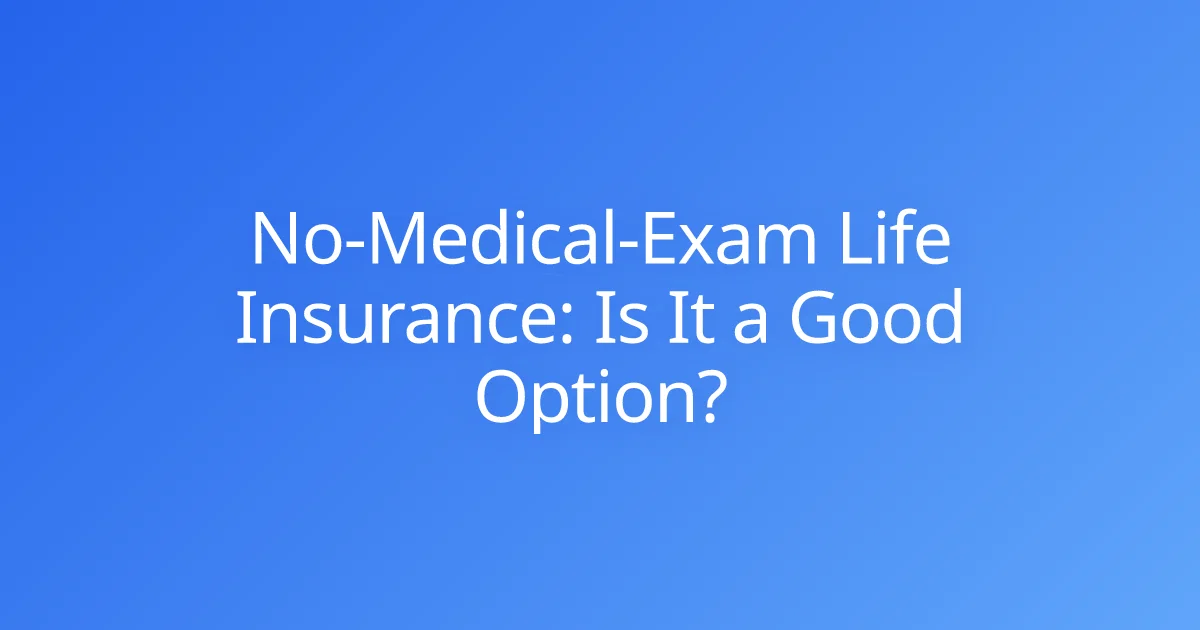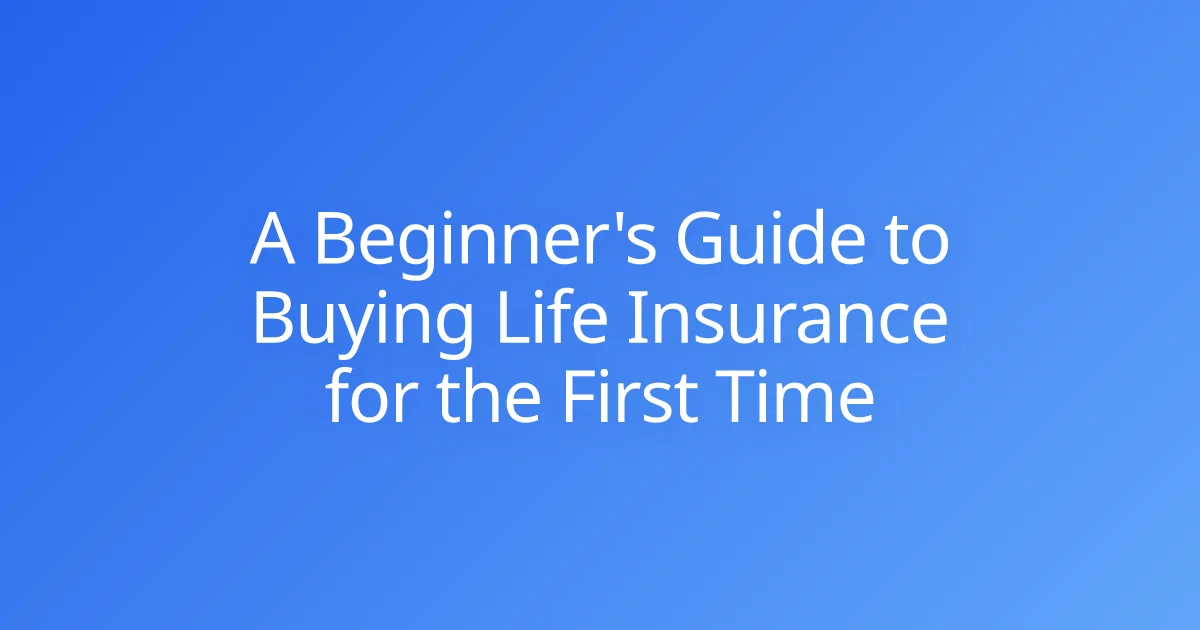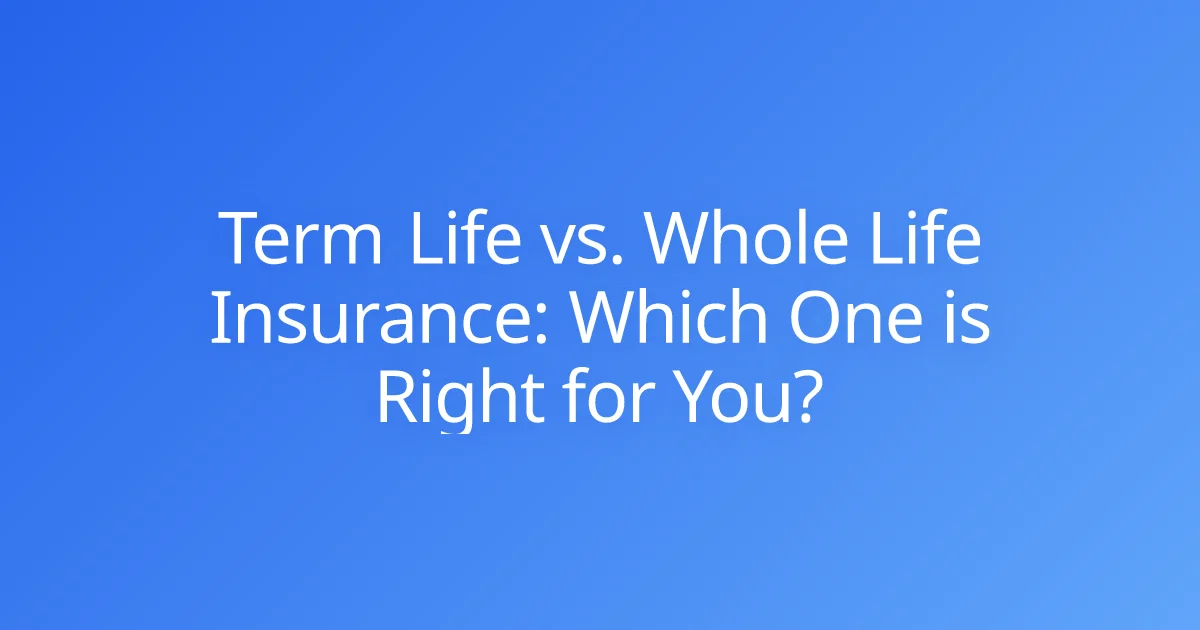No-Medical-Exam Life Insurance: Is It a Good Option?
The thought of obtaining life insurance often brings to mind medical appointments, blood tests, and lengthy underwriting processes. For many, this can be a significant deterrent, leading to procrastination or even avoiding securing crucial financial protection altogether. But what if there was a way to bypass the needles and doctor's visits? Enter no-medical-exam life insurance – an increasingly popular option promising convenience and speed.
At The Policy Explainer, we understand the desire for simplicity when navigating complex insurance concepts. This comprehensive guide will demystify life insurance without a medical exam, helping you understand its core mechanisms, explore its benefits, acknowledge its potential downsides, and ultimately determine if this streamlined approach is the right fit for your unique financial situation and protection needs. We'll empower you to make an informed decision about whether this quick life insurance solution offers the value and coverage you seek.
What Exactly is No-Medical-Exam Life Insurance?
At its heart, no-medical-exam life insurance is exactly what it sounds like: a life insurance policy you can obtain without undergoing a physical medical examination, blood work, or urine tests. Unlike traditional fully underwritten policies that require extensive health assessments, these policies rely on alternative methods to assess your risk.
Instead of an exam, insurers typically evaluate your eligibility based on:
- A detailed health questionnaire: You'll answer questions about your medical history, lifestyle, and family health.
- Database checks: Insurers may access various databases, such as the Medical Information Bureau (MIB), prescription drug databases, and motor vehicle records, to verify your health information and assess risk.
While the "no-exam" aspect offers convenience, it's crucial to understand that there are different types of these policies, each with its own level of scrutiny and implications for coverage and cost.
Simplified Issue Life Insurance
Simplified issue life insurance is one common form of no-medical-exam coverage. It typically requires you to answer a series of health questions on the application. The insurer then uses these answers, combined with database checks (like MIB or prescription history), to make an underwriting decision.
- Key Characteristics:
- No physical exam is required.
- Underwriting is faster than traditional policies, often taking days instead of weeks.
- Approval is not guaranteed; you can still be declined based on your health questionnaire or database findings.
- Coverage amounts are generally higher than guaranteed issue policies but lower than fully underwritten ones (e.g., up to $100,000 to $500,000 depending on the insurer).
- Ideal for: Individuals in reasonably good health who want quick coverage, or those with minor health conditions that might complicate a traditional medical exam but aren't disqualifying for simplified issue.
Guaranteed Issue Life Insurance
Guaranteed issue life insurance represents the most lenient form of no-medical-exam coverage. With these policies, there are typically no health questions asked, and no medical exam or database checks are performed. As the name suggests, acceptance is virtually "guaranteed," provided you fall within the specified age range (often for seniors).
- Key Characteristics:
- No health questions, no medical exam, no database checks.
- Acceptance is guaranteed for eligible age groups.
- Significantly lower coverage amounts (often capped at $5,000 to $25,000).
- Higher premiums relative to the coverage amount, reflecting the higher risk the insurer assumes.
- Almost always includes a waiting period (also known as a graded death benefit period), typically 2-3 years. If the insured dies during this period from non-accidental causes, the beneficiaries usually only receive the premiums paid back, plus a small amount of interest, not the full death benefit.
- Ideal for: Individuals with significant health issues who have been declined for other types of life insurance, or those who need coverage primarily for final expenses (funeral costs, medical bills) and have no other viable options.
The Allure: Why Choose No-Medical-Exam Coverage?
The appeal of no-medical-exam life insurance is undeniable, especially for those seeking efficiency and ease in their financial planning.
Speed and Convenience
One of the most significant advantages is the expedited application process. Without the need to schedule and undergo a physical exam, policies can be issued much faster – often within days or even hours for simplified issue policies, compared to weeks or months for traditional underwriting. This swiftness is invaluable for individuals with immediate coverage needs.
Accessibility for Certain Individuals
For those who might face challenges qualifying for traditional policies due to minor health issues, past medical conditions, or even simply a dislike of medical tests, no-medical-exam life insurance opens doors. It provides a viable pathway to obtaining coverage that might otherwise be out of reach. Guaranteed issue policies, in particular, offer a crucial safety net for individuals with severe health challenges.
Peace of Mind in a Hurry
Life can throw unexpected curveballs. A sudden job change, a new baby, an impending divorce, or an urgent need to cover a new loan might create an immediate demand for life insurance. No-medical-exam policies offer a quick solution, providing peace of mind by putting coverage in place without delay.
The Trade-Offs: Downsides to Consider
While convenient, it's essential to understand that no-medical-exam life insurance comes with certain trade-offs that might impact its suitability for your long-term financial strategy.
Higher Premiums
Without a comprehensive medical exam, insurance companies take on a greater unknown risk regarding an applicant's health. To compensate for this increased risk, premiums for no-medical-exam policies are generally higher than those for comparable traditional, fully underwritten policies. This means you might pay more for the same amount of coverage simply for the convenience of skipping the exam.
Lower Coverage Amounts
Most no-medical-exam life insurance policies offer significantly lower coverage amounts compared to fully underwritten policies. While simplified issue can go up to a few hundred thousand dollars, guaranteed issue policies are often limited to just $5,000 to $25,000. This might be sufficient for final expenses, but it's rarely enough to cover major financial obligations like mortgages, income replacement, or substantial debt.
Waiting Periods (Especially for Guaranteed Issue)
A critical consideration for guaranteed issue life insurance is the common presence of a waiting period (also known as a graded death benefit period). This period typically lasts 2 to 3 years from the policy's effective date. If the insured dies from natural causes within this waiting period, the beneficiaries usually receive only the sum of the premiums paid, plus a small amount of interest, rather than the full death benefit. The full death benefit typically only pays out if death occurs due to an accident during the waiting period or from any cause after the waiting period expires.
Less Personalization
Because the underwriting process is streamlined, no-medical-exam policies tend to be less tailored to an individual's specific health profile. This means that even if you are in excellent health, you might still pay the same higher premium as someone with undisclosed minor health issues, as the risk assessment is broader.
Is No-Medical-Exam Life Insurance Right for You? Key Considerations
Deciding whether no-medical-exam life insurance is a good option hinges on your individual circumstances, health, and financial needs.
Your Health Status
- Excellent Health: If you are in excellent health, a traditional, fully underwritten policy will almost certainly offer you significantly lower premiums for the same amount of coverage. The minor inconvenience of a medical exam could save you a substantial amount of money over the life of the policy.
- Minor Health Issues: If you have minor, manageable health conditions (e.g., controlled high blood pressure, mild asthma) that might make a fully underwritten policy more complex or expensive but aren't severe, a simplified issue policy could be a pragmatic choice.
- Significant Health Issues: If you have serious health conditions (e.g., recent cancer, heart attack, certain chronic illnesses) that make it difficult or impossible to qualify for traditional or simplified issue policies, guaranteed issue life insurance might be your only viable option to secure any form of coverage.
Your Urgency for Coverage
If you need life insurance coverage quickly – perhaps due to an urgent financial transaction, new family responsibilities, or a desire for immediate peace of mind – the speed of approval offered by no-medical-exam policies is a strong benefit.
Your Coverage Needs
- Small Debts or Final Expenses: If your primary goal is to cover modest debts, funeral costs, or other final expenses, the typical coverage limits of no-medical-exam policies (especially guaranteed issue) may be perfectly adequate.
- Large Financial Obligations: If you need substantial coverage to replace income, pay off a mortgage, fund a child's education, or cover significant business debts, the limits of most no-medical-exam policies will likely fall short. In such cases, a traditional policy is almost always necessary to secure sufficient protection.
Your Budget
Weigh the convenience of skipping the exam against the higher premiums. If budget is a primary concern and your health allows, the cost savings of a traditional policy might make the exam worthwhile.
Compare Quotes
Regardless of your initial inclination, it's always wise to compare quotes for both traditional and no-medical-exam policies. Many providers offer preliminary quotes online, allowing you to gauge the cost difference and see which option best aligns with your financial strategy and coverage requirements.
Conclusion
No-medical-exam life insurance serves a vital role in the diverse landscape of life insurance options. It provides an accessible, convenient, and rapid pathway to financial protection for those who prioritize speed, dislike medical exams, or face health challenges that preclude traditional underwriting. However, this ease often comes with the trade-offs of higher premiums and lower coverage amounts, particularly for guaranteed issue policies with their inherent waiting periods.
Ultimately, whether no-medical-exam life insurance is a good option for you depends on a careful assessment of your current health, the urgency of your need for coverage, the specific amount of protection you require, and your budget. By understanding these nuances, you can confidently determine if this streamlined approach provides the comprehensive and reliable financial security your loved ones deserve. Do you have more questions about which policy type might be best for your unique circumstances?



